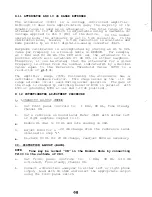
7.1 ANALOG CIRCUIT
A square wave at the desired frequency is generated by a
timer
internal to the microprocessor. This square wave is applied to
the input of switched capacitor filters for smoothing into a sine
wave. The filter section is programmed as Low Pass for all
frequencies except
8
KHz where it is configured for Band Pass.
Since there are two filter output configurations, a multiplexer
(switch) is used to route the sine wave to the attenuator block.
The attenuator is a voltage controlled amplifier set to
.5 dB
resolution by an 8 bit Digital to Analog Converter
(DAC). The
DAC, which is processor driven, controls the attenuator in the
Normal Mode at a resolution of 5.0 dB.
The
.5 dB resolution is
used only for calibration purposes in the Calibration Mode. The
total dynamic range of the attenuator is 112 dB.
required to
This range is
provide the Normal Mode HL range as well as the
overhead dB range required for calibration per frequency.
Following the attenuator is a =10 dB
range extension block.
Range extension is accomplished by increasing the gain of the OP-
Amp, which is sourced by the attenuator, by 10 dB.
The range extender circuit applies the pure tone sine wave to the
input of the output routing switches.
The switches
apply
the
signal to either the left or right power amplifier, however, it
is never applied to both simultaneously. The left and right
power amplifiers, in turn, drive the left and right earphones.
7.2 DIGITAL CIRCUIT
The heart of the digital circuitry is a MC
68HC11A1
microcomputer. This CPU was chosen for its flexibility and
low
power consumption. Functions available from the device are (5) 8
bit programmable I/O ports,
(A/D),
an
8
bit analog to digital converter
8
K Bytes of ROM, 256 Bytes of RAM, 512 Bytes of EEPROM,
Counter/Timer,
and Serial Port Interface. As a result, there are
very few external support devices required. If there is an
external EPROM (32 K Bytes), a programmable timer, and
miscellaneous decodes, line multiplex, etc.
The CPU executes the commands stored in ROM and EPROM. These
instructions are the result of a front panel command in
conjunction with look-up tables, and such, for
applying
the
pertinent calibration data for the selected parameters. Such
parameters could be: HL calibration for a specific frequency,
clock frequencies for the switched capacitor filters, display
instructions, or as simple as an ON/OFF command to a CMOS switch.
In summary, the digital circuitry in the GSI 17 controls the
analog and display circuitry in such a manner that
the front
panel selections are processed and acted upon accordingly.
Summary of Contents for Grason-Stadler GSI 17 1717-9700
Page 1: ...Covers Welch Allyn AM232 Audiometer ...
Page 5: ......
Page 6: ......
Page 7: ......
Page 8: ......
Page 17: ...R 3 P io R 5 Figure 2 1 CONNECTORS CONTROLS INDICATORS 8 ...
Page 23: ......
Page 24: ......
Page 43: ......
Page 44: ......
Page 49: ......
Page 50: ......
Page 53: ......
Page 54: ......
Page 66: ......
Page 67: ......
Page 69: ......
Page 79: ......
Page 80: ......
Page 81: ......
Page 82: ......
Page 83: ......
Page 84: ......
Page 89: ......
Page 90: ......
Page 91: ......
Page 92: ......
Page 93: ......
Page 95: ...Figure 10 2 BATTERY POWER CONNECTION 88 ...
Page 98: ... v7044 0037 17 17 0406 Figure 10 3 NiCad BATTERY OPERATION 9 1 ...
Page 100: ......
Page 102: ......
Page 103: ......















































